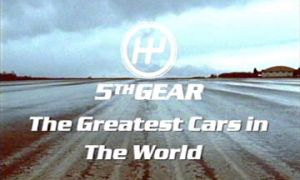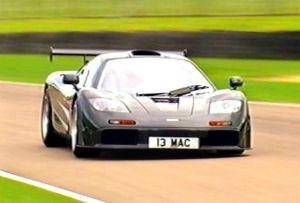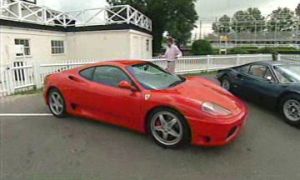Fifth Gear/The Greatest Cars in The World Special
| The Greatest Cars in The World | |
|---|---|
|
| |
| No. | 12 |
| Next ep. | James Bond's Cars |
| Prev. aired | Series 1, Episode 11 |
| Next aired | Series 2, Episode 1 |
| Airdate |
|
The Greatest Cars in The World Special of Fifth Gear aired on the 8th September, 2002. As a standalone special, the programme was the 12th episode overall. It was the 12th programme to air in 2002 out of a total 22. The Greatest Cars in The World Special was originally broadcast in 576i at a 16:9 Widescreen aspect ratio on British television channel Channel 5. The episode was presented by Tiff Needell and Vicki Butler-Henderson, with no other hosts presenting a piece to camera that week. Quentin Willson and Adrian Simpson are also credited, however, no footage featuring these two presenters is presently known to have surfaced, and may just be a miscredited appearance.
Synopsis
The Greatest Cars in The World was a special filmed at a race track where Tiff and Vicki set out to determine the greatest car ever made.
Opening up with a shot of Vicki walking in a pair of stiletto high heels while seductively rubbing her finger along the bodywork of a Lamborghini Murciélago, she announces the purpose of the episode before a few close shots of a Ferrari 360 Modena are shown, with Tiff Needell then proceeding to narrate a brief history of the company as it approaches its 60th year of operation. Accompanied by a Ferrari Daytona and Dino 246 GT, Tiff then exclaims that contrary to popular belief, he believes the greatest Ferrari ever made is not one of their well-renowned classic models, but rather their (as of 2002) most recent sports car; the 360 Modena.
Nominee 1: Ferrari 360 Modena
He says this because he prefers the Modena's advanced technology and modern design against its older contemporaries, with its ever-increasing acceleration, braking, and handling attributes. He also prefers the seating position and the overall build quality of the car, as he feels this allows the driver to focus on the most important thing; driving. If Needell had the opportunity to own one, he'd buy one tomorrow; a manual hardtop in red. He subsequently starts the car, revs the engine, and puts into Sport mode before taking it for a spin around the circuit. He commends the 360's ease to control for less experienced drivers, all the while powersliding it and praising the car for its excellent balance. As a television presenter, Needell states that he gets to drive a lot of very good cars, but often tires of them after a day of filming. Not so with the 360; which he feels is the greatest-ever production line Ferrari. However, every once in a while, Ferrari make something that is truly special, and there is one car which Tiff feels trumps the 360.
Nominee 2: Ferrari F40
Enter the F40. Released in 1987 to celebrate the company's 40th birthday and only ever intended as a limited run of 400[1] cars, plus a 401st for Niki Lauda, demand for the F40 was so great they would be produced for 5 years for a total production figure of 1,315, annoying some early buyers. Even as of 2002, the car remains the definitive supercar, obscenely light, lighter than the current MINI, and is very rough in nature, making it a race car for the road. Capable of a top speed of over 200 MPH, what more could a man want?
Needell reveals a secret to the audience; he has never driven a Ferrari F40 before, but the prospect leaves him 'tingling' with anticipation. Strapped in with a Sabelt harness, Needell takes note of how crude the interior's construction is, with bare carbon fibre visible and a less-than ideal steering wheel and pedal placement. However, for all its fault, Needell knows there's nearly 500 BHP waiting to be unleashed behind him, and cruising the F40 at 3000 RPM leaves little hint that this is the case; it almost feels like a "shopping car"[2] with little to fear. Then he engages the turbochargers. There's no sudden surge or lag as many cars of the era suffered from, just instant power. The chassis is also very firm with no roll to it. As a whole, the car has very distinct racing pedigree, with heavy brakes and no electronic assists. He tries to see how much power he can enter a corner with, but decides against powersliding, otherwise the F40 would simply spin out of control.
On reflection, Tiff feels the F40 is a truly sensational car, both visually and physically. The car feels like a "monster" that doesn't "bite"; it just wants to make you go faster and faster. Compared against the later 360, the two cars complement each other well, and is a 'tremendously emotional' experience to get behind the wheel of either. He cannot wait to see what the company comes up with next.
Winner: McLaren F1
However, there is only one car that can be truly considered the greatest of them all; the McLaren F1.
Arriving in a helicopter, Needell gleefully points out the car as it's parked in the middle of a field. With a top speed of over 240 MPH, the F1 can cover a mile in just 15 seconds. Despite being out of production for a number of years at this point, the car still holds numerous records in factors such as acceleration, as well as the fastest speed set around a circuit for a production car, which was set[3] by Needell at Millbrook Proving Ground back in 1999. He first drove the car back in 1994[4] and eight years later, that review remains the one people ask him about the most. He gets inside the car for the first time in quite a while, and does a doughnut on the field before setting off.
Tiff feels the car isn't the greatest just because it's the fastest, but because it 'transcends' the very meaning of what normal cars stand for and sets its own rules, largely due to designer Gordon Murray's ingenious design of a centralised cockpit and carbon-fibre monocoque. During its unveiling[5] at the 1992 Monaco Grand Prix, the event was intended to allow an elite audience of rich and famous people to take a look at it, but the stir it caused meant no-one was able to get a decent look. Nowadays, the sole remaining F1 can be seen on full display at the McLaren dealership in Park Lane, the only car dealership Needell can name which doubles as a tourist attraction. With only 100 examples ever being produced, the car is as exclusive as it gets, with no accountants or marketers involved in its design; just people who loved cars, and a select few racing drivers. Unlike the F40 however, the F1 is not merely a racing car for the road; it was designed with zero compromises, and was built to accommodate 3 adults and their luggage. In order to achieve this technical feat, the car comes at a hefty cost: £634,500.
At such a cost, the car has an engine bay lined with gold, the best heat-conducting material available, which houses the 6.1 litre naturally-aspirated BMW V12. After just one day in a wind tunnel, the car won the illustrious 24 Hours of Le Mans against a plethora of prototypes. Despite production having ceased in 1998, the company's customer care remains the best there is, with cars being resprayed in colours ranging from aubergines to watch faces. Others preferred their names to be monogrammed into the carbon fibre, and if you were to buy one used, McLaren will spend 3 months re-building and re-trimming it to factory condition, as well as outfitting it with gadgets such as satellite navigation and support for mobile phones. Every job done to an individual car, no matter how small, ends with a comprehensive 4 hour valet.
Daily driving and final thoughts
However, as mighty as the F1 may seem, what is perhaps its 'best trick' is the fact the car can be used as daily transport. Tiff takes the car through city streets and fills up at a normal petrol station, and although one owner tells him that having a crash in one is expensive enough to buy a Ferrari, this doesn't detract from its usability around town. After having driven the car several times in the past including this particular occasion, Tiff still feels his original 1994 test drive was the best one he ever did. The thing he remembers the most about that day is when he finally dropped the car into second gear and stepped on the throttle after half a day of puttering around public roads. To bring the episode to a close, Tiff takes the car to a circuit to see how fast he can drive it, reaching speeds of over 160 MPH. He feels it isn't just the F1-like central driving position that makes the experience of driving one, but the whole feel of the car, including the steering and the brakes. He loves how the car feels "so alive", and slates other critics who feel the brakes aren't good enough or that the car feels a bit twitchy, to which Needell doesn't deny the latter, but revels in that notion. It may cost more than half a million pounds, but McLaren never made any profit; an experience one could describe as being worth every penny. Despite being 10 years old, the car remains as fresh as the day it was made, and firmly deserves the accolade Greatest Car in The World. Tiff cannot see anything ever beating it.
Credits (partial)
Presenters
Vicki Butler-Henderson
Tiff Needell
Adrian Simpson
Quentin Willson
Camera
Michael Caine
Barrie Foster
Rob Pike
Robin Sunderland
Airing history
| Channel | Date | Time | Cut | Definition | Type |
|---|---|---|---|---|---|
 |
8th September, 2002 | 20:00 | Original | Standard | Premiere |
After this, the episode aired on the Discovery Channel sometime on or immediately prior to the 21st July, 2003[6], where it was recorded, digitised, and uploaded to the internet by Jabba355. From there, it was likely sold to Viasat for its Explorer television series, as part of the 48 programmes distributed to the network in mid-2004, where it would have been reshown countless times until early 2007.
Featured cars
The Greatest Cars in The World Special featured 7 vehicles in total. Note that only cars which the camera is directly focused on and/or interact with any of the presenters are included; traffic, toy cars, pictures of cars and stock/archive footage are not included. For the most part, timestamps have been rounded to the nearest quarter of a minute, except in situations where they need to be distinguished from other cars which appear at similar times.
This list is based on the surviving Jabba355 rip of the episode, and does not factor in international or domestic cuts, nor does this list incorporate vehicles featured in deleted footage.
| Car/Registration Plate | Colour | Timestamp | |
| Lamborghini Murciélago | Azzurro Aquarius | 0:30 | |
| N/A | Role: Cameo | Scene: Immediately after the introduction sequence. | |
| Ferrari Daytona | Blu[7] | 1:00 | |
| N/A | Role: Cameo | Scene: Used to introduce the 360 Modena. | |
| 1971 Dino 246 GT | Blu Scuro | 1:00 | |
|
Role: Cameo | Scene: Used to introduce the 360 Modena. | |
| 2002 Ferrari 360 Modena | Rosso Scuderia | 1:15 | |
|
Role: Tested car | Scene: Ferrari 360 Modena track test. | |
| 1989 Ferrari F40 | Rosso Corsa | 4:00 | |
|
Role: Tested car | Scene: Ferrari F40 track test. | |
| 1997 McLaren F1 | Magnesium Silver | 7:30 | |
| Chassis 065 | Role: Cameo | Scene: Outside McLaren's Park Lane dealership. | |
| 1994 McLaren F1 LM | Carbon Black | 7:45 | |
|
Role: Tested car | Scene: McLaren F1 track test. |
Soundtrack
The Greatest Cars in The World Special, contained the following tracks:
▶️ David Lowe - Fifth Gear Theme: Plays during the opening and closing sequences.
▶️ Duar Vila - C'Mon: Plays during the scene where Tiff drives the F1 down city streets.
Of the episode's soundtrack, an uncertain number of songs featured remain unidentified. Throughout the episode, an Oasis-like Britpop instrumental is heard, which is interspersed with an electronic track which may or may not be part of the same piece of music.
Preservation status
Due to the work of archivists, The Greatest Cars in The World can be watched in a largely-intact form, albeit not at the original resolution, aspect ratio, nor bitrate, with approximately one third of the episode remaining missing. Otherwise, the episode would be considered lost media. As of the 2020s, this special is completely extinct on the internet since the deletion of Ely Liu's webspace and disappearance of the file from P2P networks and other file sharing means such as eD2k.
Trivia
- This was the first non-regular episode of Fifth Gear to air, and is not included in most episode guides.
- The Ferrari 360 Modena featured in this episode, RV02 ONL, was a very well-known press car from around this time. It appeared in promotional material, as well as the introduction sequence for Top Gear's 2002 relaunch, in addition to an episode of Used Car Heaven, where it was driven by Richard Hammond, and several magazine issues including one for Top Gear Magazine, as well as the June 2003 issue of Auto Italia.
- The Ferrari F40 featured in this episode, F40 NPG, was an example owned by Pink Floyd drummer Nick Mason and has made numerous appearances in other automotive journalism media, perhaps most notably in Jeremy Clarkson's 1998 home video release Most Outrageous.
- The McLaren F1 LM featured in this episode, 13 MAC, better known by its internal designation of Chassis 020[8], would later appear in Series 2, Episode 1 of Top Gear, where it was driven by legendary Formula 1 commentator Murray Walker. This film would be omitted from later broadcasts, but was thankfully retained in an abridged version for the programme's 2003 home video release Top Gear: Back in the Fast Lane.
Goofs
- Tiff Needell states that he drove the McLaren F1 in 1992. This is wrong, as the car was only a prototype at that point, one which was looked at by Jeremy Clarkson for Series 28, Episode 5 of Top Gear, which did indeed air that year. However, Needell's drive happened in the final episode of Series 31, 2 years later, and was reshown as part of the programme's 1994 home video release, Super Cars.
- He might be confusing it with the test drive of the Jaguar XJ220, which he did do in 1992.
- Tiff also confuses the example of the McLaren F1 on display at the company's Park Lane dealership as having been "sealed in since day one", Chassis 065, with the XP3 Prototype that was later converted into a road car at the behest of designer Gordon Murray. Both are silver, and the latter would eventually appear in Fifth Gear for Series 21, Episode 5.
References
- ↑ Harper, B. (2022) 'Ferrari F40 – review, history, prices and specs', Evo, 13th July.
- ↑ Needell definitely says, "car", not "cart". Those are called "trollies" in the UK.
- ↑ Meaden, R. (2019) 'Think race circuits are scary? You should try a test track or proving ground.', evo, 4th June.
- ↑ Tiff says "1992", but he is mistaken, as the car was not in general production at that point.
- ↑ evo - The original McLaren F1 press release in full.
- ↑ Automotive Forums - 5th Gear Footage.
- ↑ Either Blu Dino or Blu Sera.
- ↑ Supercar Nostalgia - VIN: Tony Smith's McLaren F1 chassis 020.
| ||||||||||||||
- Episodes
- Special episodes
- Episodes of Fifth Gear
- Special episodes of Fifth Gear
- Episodes which aired on 8th September
- Episodes of Fifth Gear which aired on 8th September
- Episodes which aired in 2002
- Episodes of Fifth Gear which aired in 2002
- Episodes broadcast in 576i
- Episodes of Fifth Gear broadcast in 576i
- Episodes broadcast at 16:9 Widescreen aspect ratio
- Episodes of Fifth Gear broadcast at 16:9 Widescreen aspect ratio
- Episodes broadcast on Channel 5
- Episodes of Fifth Gear broadcast on Channel 5
- Episodes presented by Tiff Needell
- Episodes of Fifth Gear presented by Tiff Needell
- Episodes presented by Vicki Butler-Henderson
- Episodes of Fifth Gear presented by Vicki Butler-Henderson
- Automotive journalism media which feature "David Lowe - Fifth Gear Theme" in its soundtrack
- Automotive journalism media which feature "Duar Vila - C'Mon" in its soundtrack
- Automotive journalism media which feature unidentified music
- Automotive journalism media which feature an uncertain number of unidentified music tracks
- Found Fifth Gear media


